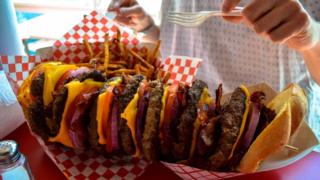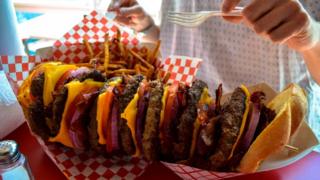The secrets of ‘food porn’ viral videos
Is the fashion for filming calorie-saturated food videos encouraging unhealthy eating? …

 Image copyright Getty Images
Image copyright Getty Images I’ve just watched a fresh turkey being covered in fragments of cheese-flavoured crisps and then stuffed with what looks like three kilos of cheddar.
The video has more than four million views on YouTube. Call it a stunt, call it a travesty, whatever you make of it this is food – but not as you know it.
It’s an extreme example of a so-called “food porn” video, a viral clip of an excessively indulgent recipe designed to shock or delight in equal measure.
While responses to the cheese-stuffed turkey video were mixed to say the least, videos that revel in stringy, gooey melted cheese, lashings of melted chocolate, or heinous quantities of barbecue sauce are all the rage. Observe a rainbow bagel filled with cream cheese or a 100-layer lasagne in the making.
They are shared far and wide on social media and evidence is growing to suggest that they are changing consumer expectations. Some of the most well-known creators behind these videos include Tasty, BuzzFeed Brand, Twisted, Spoon University and Chefclub.
Their clips take the form of visual recipes, usually filmed in a top-down format, focusing entirely on the food itself and cooking utensils. The final shots often show slow-motion close-ups of the resulting dish.
“For me, watching those kind of things the initial reaction is, they’re disgusting, they’re so gross, they’re also incredibly wasteful, they’re ludicrously unhealthy,” says Thom Eagle, food writer and freelance chef.
“The term ‘food porn’ is apt because it’s completely unrealistic.”
And yet Mr Eagle, who specialises in modern restaurant cuisine and fermentation recipes, has witnessed the power of social media. Stick a dish on Instagram, he says, and the punters will come looking: “That’s what sells the most the next day at the restaurant.”
People nowadays like to eat exactly what they want, when they want it, and are – for instance – increasingly using food delivery apps for that purpose.
The meal delivery market in the UK grew 13.4% year-on-year in 2018 and is up again this year, according to industry data, says Kim Malley at the Agriculture and Horticulture Development Board (AHDB).
It’s a safe bet that apps have revolutionised the sector, she says.
But what about videos of food? There are clues there too. The AHDB tracks consumer opinion on cooking and food purchasing habits. The body asks what sources people use to inspire their cooking at home.
“12% claim that they’ve looked at YouTube for recipe inspiration,” she says. “To put that into perspective, in 2015 that was only at 4%.”
Firms that make the ingredients we cook with are keen to cash in on the eye-popping food craze. One marketing agency that works with brands to make social media videos in this style is Dish Works, based in Pennsylvania.
“I think that cheese is maybe one of the sexiest things you can use in a video,” says Mary Bigham, president and co-founder.
“When you see cheese pulls and melty, bubbly cheese, you gotta stop and look at it.”
She calls it “stretch appeal” and says her team have a heat gun in their studio so that when pizzas, tacos or quesadillas are being filmed, the cheese can be coaxed to just the right level of lusciousness.
This visual language is not confined to cheese. Ms Bigham says that condiments like ketchup or mayonnaise, dressings and unctuous sauces poured in slow motion can all improve the likelihood that viewers will salivate over of the final video.
One New York restaurant capitalised on exactly this a few years ago. Raclette NYC serves raclette, a Swiss cheese that is usually brought to the table heated and melting. It is then scraped on to other things on your plate.
Raclette NYC posted a video showing off its dishes online and was immediately swamped with eight million views online overnight. The next day, the restaurant was overwhelmed with customers and the head chef had to hire 10 new staff members to cope with demand.
This is the effect food companies, restaurants and influencers are all chasing.
Ms Bigham says that the general goal for many purveyors of food porn is to nudge the viewer into wanting to try to make the dish at home for themselves. It looks delicious – and straightforward to make – so why not?
That does raise a question, though. As Mr Eagle points out, a lot of these recipes are unhealthy. Cheese is high in salt and saturated fat – a little goes a long way. Plus, the portion sizes in many viral food videos are gargantuan.
For her part, Ms Bigham argues she’s never had a client request a video that she felt was unreasonably unhealthy.
But if excess is part of what makes many food videos go viral, that could be bad news for the obesity epidemic.
“My opinion is that these videos, they really show recipes which are calorific, they contain an excessive amount of fat,” says Roberta Alessandrini, a nutritionist at Queen Mary University of London, referring to widely shared clips of deep-fried pizzas and towering burgers.
“They don’t really depict an idea of what a healthy diet should be. On the other [hand] I think that cooking is a positive thing.”
Dr Alessandrini says research indicates that people who cook at home often have better diets overall.
If constructing the occasional 100-layer lasagne gets them into the kitchen, perhaps the overall effect might be a good one?



